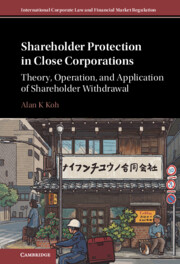 Shareholder Protection in Close Corporations
Shareholder Protection in Close Corporations from Part 4 - Conclusion
Published online by Cambridge University Press: 14 October 2022
Chapter IX summarizes this Book’s key findings and explores applications and extensions of the corporate law concepts and comparative law methodology developed in this Book. This Book contributes to legal scholarship in three ways. First, it establishes a coherent set of corporate law concepts and terminology that clarifies and expands our understanding of shareholder conflict and withdrawal across diverse jurisdictions. Second, it develops and applies a novel comparative law method (named the ‘tripartite method’). Third, I identify and analyse the phenomenon, which I call ‘spontaneous functional convergence’, in withdrawal law. This subtype of convergence occurs where jurisdictions appear to have – largely independently of other jurisdictions – developed legal regimes that are functionally similar but formally different using mostly, if not exclusively, domestic legal sources and inspirations. The spontaneous convergence observed in the withdrawal regimes of the target jurisdictions point to withdrawal as an evolutionary milestone for close corporation law.
To save this book to your Kindle, first ensure no-reply@cambridge.org is added to your Approved Personal Document E-mail List under your Personal Document Settings on the Manage Your Content and Devices page of your Amazon account. Then enter the ‘name’ part of your Kindle email address below. Find out more about saving to your Kindle.
Note you can select to save to either the @free.kindle.com or @kindle.com variations. ‘@free.kindle.com’ emails are free but can only be saved to your device when it is connected to wi-fi. ‘@kindle.com’ emails can be delivered even when you are not connected to wi-fi, but note that service fees apply.
Find out more about the Kindle Personal Document Service.
To save content items to your account, please confirm that you agree to abide by our usage policies. If this is the first time you use this feature, you will be asked to authorise Cambridge Core to connect with your account. Find out more about saving content to Dropbox.
To save content items to your account, please confirm that you agree to abide by our usage policies. If this is the first time you use this feature, you will be asked to authorise Cambridge Core to connect with your account. Find out more about saving content to Google Drive.